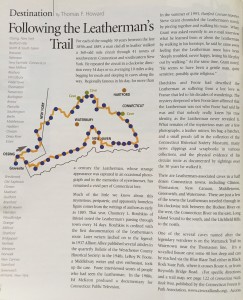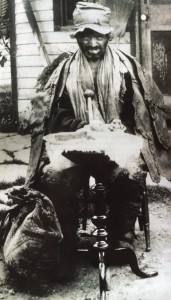By Thomas F. Howard WINTER 2007/08
For each of the roughly 30 years between the late 1850s and 1889, a man clad all in leather walked a 360-odd mile circuit through 41 towns of southwestern Connecticut and southeastern New York. He repeated the circuit in a clockwise direction every 34 days or so, averaging 10 miles a day, begging for meals and sleeping in caves along the way. Regionally famous in his day, for more than a century the Leatherman, whose strange appearance was captured in an occasional photograph and in the memories of eyewitnesses, has remained a vivid part of Connecticut lore. 
Much of the little we know about this mysterious, peripatetic, and apparently homeless figure comes from the writings of authors as early as 1885. That year, Chauncey L. Hotchkiss of Bristol noted the Leatherman’s passing through town every 34 days. Hotchkiss is credited with the first documentation of the Leatherman’s route. Later writers latched on to the legend: in 1937 Allison Albee published several articles about the Leatherman in the Quarterly Bulletin of the Westchester County Historical Society. In the 1940s, LeRoy W. Foote, a Middlebury writer and cave enthusiast, took up the case. He interviewed scores of people who had seen the Leatherman. In the 1980s, Ed McKeon produced a documentary for Connecticut Public Television.
In the summer of 1993, Hartford Courant reporter Steve Grant chronicled the Leatherman’s route by piecing together and walking his route. When Grant was asked recently in an e-mail interview what he learned from or about the Leatherman by walking in his footsteps, he said he came away feeling that the Leatherman must have been “deeply troubled, never happy, letting his life play out by walking.” At the same time, Grant noted, “He seems to have been a gentle man, quite sensitive, possibly quite religious.”
Hotchkiss and Foote had described the Leatherman as suffering from a lost love in France that led to his decades of wanderings. The mystery deepened when Foote later affirmed that the Leatherman was not who Foote had said he was and that nobody really knew his true identity, as the Leatherman never revealed it. What remains of the mysterious man are a few photographs, a leather mitten, his bag, a hatchet, and a small pouch (all in the collections of the Connecticut Historical Society Museum), many news clippings and scrapbooks in various collections, and the physical evidence of his circular route as documented by sightings over the 30 years he walked it.
There are Leatherman-associated caves in a half dozen Connecticut towns, including Clinton, Thomaston, New Canaan, Middletown, Greenwich, and Watertown. These are just a few of the towns the Leatherman traveled through in his clockwise trek between the Hudson River on the west, the Connecticut River on the east, Long Island Sound to the south, and the Litchfield Hills to the north.

“Old Leatherman” at the Fisher home, Meriden Road, Middletown, Connecticut, c. late 18802. Connecticut Historical Society.
One of the several caves named after the legendary wanderer is on the Mattatuck Trail in Watertown near the Thomaston line. It’s a so-called fissure cave some 40 feet deep and can be reached via the Blue Blaze Trail either in Black Rock State Park, where it crosses Route 6 or from Reynolds Bridge Road. (For specific directions and a trail map, see page 122 of Connecticut Walk Book West, published by the Connecticut Forest & Park Association, www.ctwoodlands.org) Access to the park and other trailheads is from Route 8, Exit 38 and west on Route 6.
Another well-known Leatherman cave is Tory Den on the Burlington/Harwinton line (named for Loyalist Harwinton farmer Steven Graves, who hid out there to avoid fighting with the patriots during the Revolutionary War). It’s accessed off the Tunxis Mainline Trail (For specific directions and a trail map, see page 299 of Connecticut Walk Book West.) It was in Middletown, apparently in the 1880s, that the Leatherman posed for one of the few known photographs of him. The photo was taken by Moore’s Studio of Middletown and can be seen along with a few others at Connecticut History Online (www.cthistoryonline.org).
Also in Middletown, the Leatherman’s story took an interesting twist. Late in his life he developed a cancer of the lip and jaw that appeared to be getting worse. Some people of good intentions felt he needed help and appealed to the authorities to do something. He was brought under guard to a Hartford hospital—probably Hartford Hospital— for treatment but quickly escaped when the guards left. In 1889 he would die from this affliction, but while he lived he continued on his clockwise journey.
The Leatherman hiked to the summit and cave on Mount Higby in southwestern Middletown and northwestern Middlefield. Today the Mattabessett Trail, another of Connecticut’s great blue-blaze trails run by the Connecticut Trails Council of Middlebury, points the way to a spectacular view from 820-foot heights. From there, the Leatherman went to the lowlands of the Connecticut River valley and the quaint river towns of Haddam, Chester, Essex, and Old Saybrook. He sometimes walked the railroad tracks to get to his destinations.
During the Leatherman’s day, people in 41 towns accepted him, fed him, some feared and taunted him, and fed the legend as this eccentric spent his life visiting and living in Connecticut’s natural wilderness.
